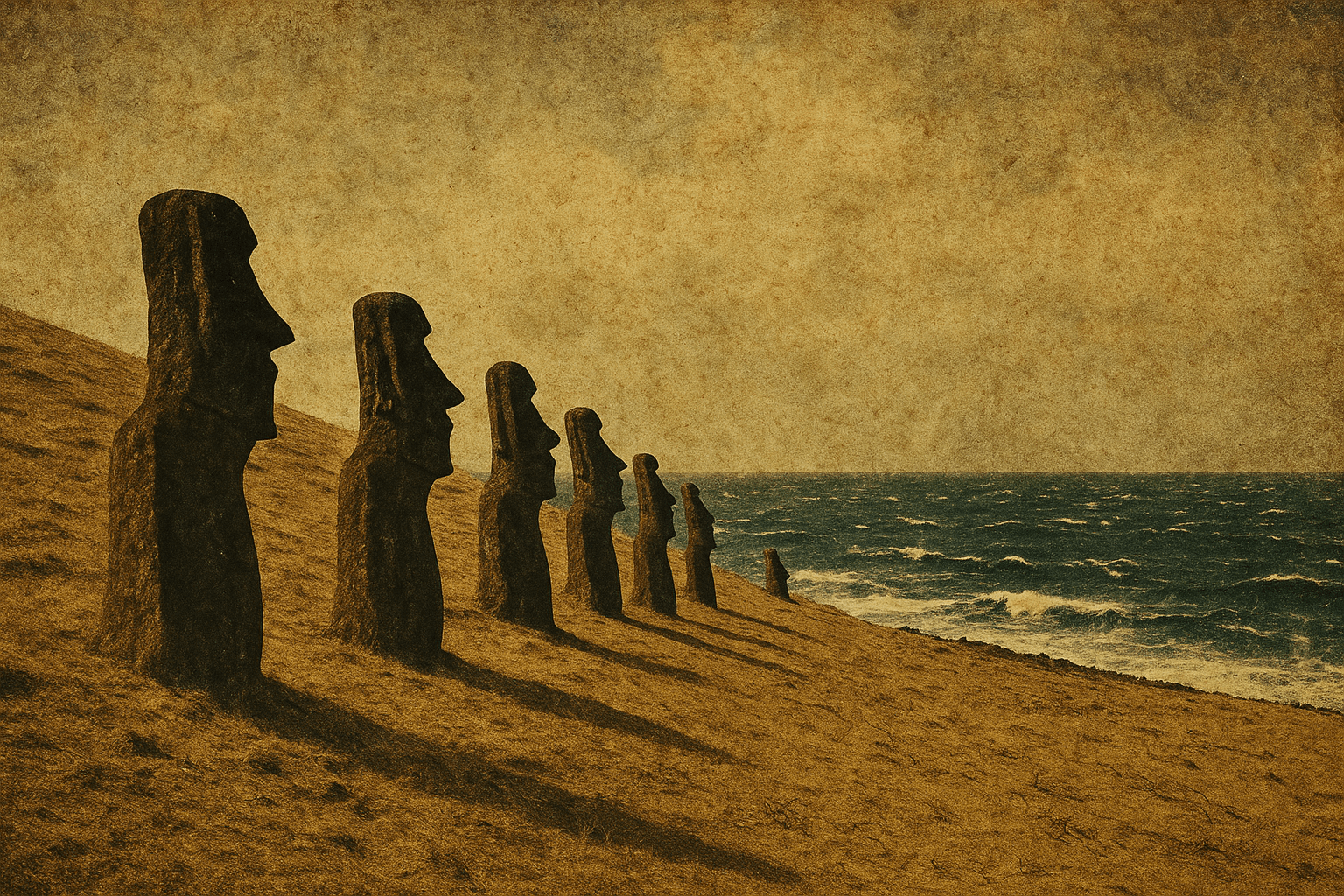The Classic Tale: A Cautionary Story of Ecocide
The ecocide hypothesis, most famously popularized by scientist and author Jared Diamond in his 2005 book Collapse, paints a grim picture of a society that engineered its own destruction. The narrative is compelling and simple, serving as a powerful allegory for modern environmental concerns.
According to this theory, when Polynesian settlers first arrived on Rapa Nui around 800-1200 CE, they found a subtropical paradise teeming with life. The island was covered in a dense forest of giant palms, a resource that would prove both essential and, ultimately, finite. The Rapa Nui people, driven by clan rivalry and religious devotion, entered into a feverish competition to erect ever-larger and more elaborate moai.
This massive undertaking required immense resources. The palm forests were systematically cleared for several reasons:
- Transporting the Moai: The giant logs were likely used as rollers or as part of a “ladder” system to move the multi-ton statues from the quarry at Rano Raraku to their ceremonial platforms (ahu) along the coast.
- Agriculture: Land was cleared for planting sweet potatoes and other crops to feed a growing population.
- Canoe Building: Large, sturdy canoes were necessary for deep-sea fishing, a crucial source of protein.
The deforestation was relentless. As the last trees were felled, the consequences were catastrophic. Without tree roots to hold it in place, the topsoil washed into the sea, devastating crop yields. Without wood for canoes, the islanders could no longer fish for dolphins and tuna. Food sources dwindled, leading to starvation, social breakdown, and brutal warfare between clans. Archaeologists point to the proliferation of obsidian spearheads, called mata’a, and oral traditions of cannibalism as evidence of this “dark age.” In this telling, the Rapa Nui people, trapped on their remote island, had recklessly consumed their world into oblivion.
Re-examining the Evidence: A Story of Resilience
For decades, the ecocide theory was the accepted explanation. In recent years, however, a new generation of archaeologists, notably Terry Hunt and Carl Lipo, have challenged this narrative, arguing that it oversimplifies the past and unfairly maligns the ingenuity of the Rapa Nui people.
Their research suggests that while deforestation certainly occurred, humans were not the sole culprits. A second actor played a devastating role: the Polynesian rat (Rattus exulans). These rats, which arrived as stowaways on the first settlers’ canoes, found an island with no natural predators. Their population exploded, and they feasted on the nuts of the giant palm trees, effectively preventing the forest from ever regenerating. The deforestation, then, was less a story of pure human recklessness and more of a complex ecological disaster triggered by an invasive species.
Furthermore, Hunt and Lipo argue that the Rapa Nui were not helpless victims of their changing environment but brilliant adapters. As the landscape became more exposed and windswept, they developed innovative agricultural techniques:
- Rock Gardens (Lithic Mulch): Islanders discovered that covering their gardens with a layer of broken volcanic rock protected the soil from erosion, helped retain moisture, and released valuable minerals.
- Manavai: They built thousands of circular stone enclosures to protect delicate crops like taro from the wind.
These methods allowed them to sustain a stable population for centuries, even after the forests were gone. The idea of a massive, pre-contact population crash due to resource wars is also being re-evaluated. Re-dating of archaeological sites suggests the population remained relatively stable through the period of deforestation and moai construction. The real collapse, this new theory argues, came later and from a different direction.
The Impact of the Outside World: Disease and Slavery
If the Rapa Nui didn’t starve themselves into oblivion, what caused their society’s final, tragic downfall? The evidence points overwhelmingly to the devastating impact of outside contact.
When Dutch admiral Jacob Roggeveen became the first European to land on the island on Easter Sunday, 1722, he described a mixed scene of a functioning society amid a barren landscape. While the island was treeless, he noted garden plots and a population he estimated at a few thousand people. It was the subsequent waves of visitors that brought annihilation.
European ships introduced communicable diseases like smallpox and tuberculosis, to which the isolated Rapa Nui had no immunity. Epidemics swept through the population, killing untold numbers. But the most catastrophic blow came in the 1860s. Peruvian slave traders descended on the island, abducting roughly 1,500 people—about half the remaining population—to work in horrific conditions in the guano mines of Peru. Among those taken were the island’s king, his heir, and the last of the priestly class who could read the island’s unique script, rongorongo.
Though a handful of the enslaved Rapa Nui were eventually repatriated, they brought smallpox back with them, triggering another deadly epidemic. By 1877, the island’s population numbered just 111 individuals. This was the true collapse—not a slow decline from environmental mismanagement, but a swift and brutal demographic catastrophe caused by foreign violence and disease.
A Complex New History
The story of Easter Island is no longer a simple morality play. It is a far more complex and, in many ways, more tragic tale. The Rapa Nui did face immense environmental challenges, partly of their own making but greatly exacerbated by invasive rats. Yet, they did not passively watch their world crumble. They adapted, innovated, and survived for centuries in a difficult landscape, maintaining their vibrant culture and continuing their incredible moai-building tradition long after the palms were gone.
The “mystery” of their collapse is, perhaps, not a mystery at all. They were a resilient people who were ultimately overwhelmed not by their own failures, but by the guns, germs, and greed of the outside world. The silent moai are not monuments to a foolish society that destroyed itself, but to an ingenious one that was tragically destroyed.
